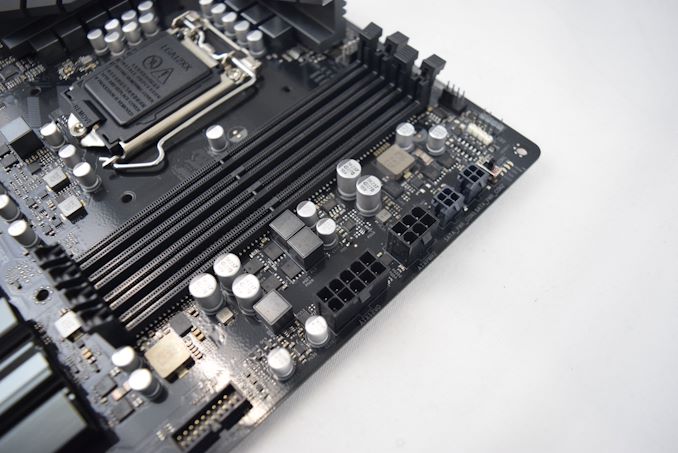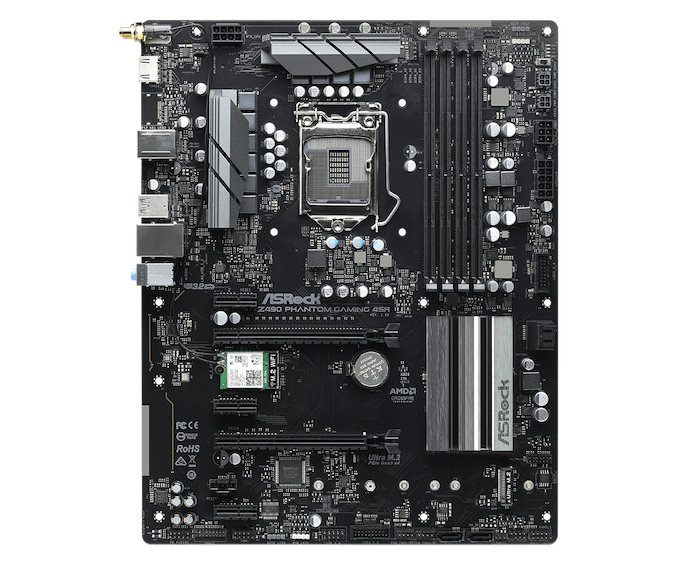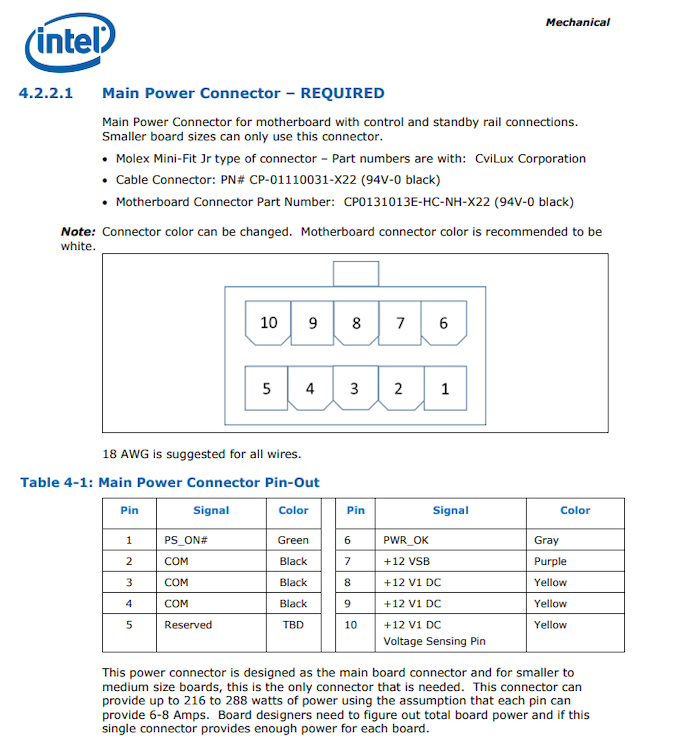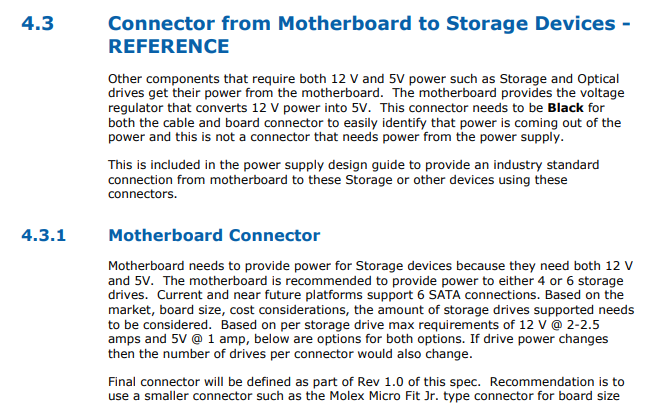First ATX12VO Consumer Motherboard: The ASRock Z490 Phantom Gaming 4SR
by Dr. Ian Cutress on May 5, 2020 12:00 PM EST- Posted in
- Motherboards
- Intel
- ASRock
- Z490
- ATX12VO

One of the biggest legacy characteristics of the modern PC is how the power supply connects to the motherboard – not only is it one big chunky 24-pin power connector in to the board, but it has to supply all of the relevant voltages, including 12 V, 5 V, and 3.3 V. Over the last two decades, standards that used 5 V and 3.3 V have almost disappeared, except for a last few legacy applications. Despite that, we’ve been lumbered with the old ATX12V standard for this. However recently the ATX12VO standard was announced, requiring only 12 V into the motherboard and other voltages to be derived from it on the board. This also allows the power supply to be more efficient and compact, with a smaller connector. At the time, given the ubiquity of the ATX12V standards, we were all under the impression that ATX12VO would be something for the embedded market, where the full hardware stack could be customized top-to-bottom. A blog post from Intel showcased the first consumer motherboard with the standard from ASRock, and we reached out to ASRock for more details. They have now put up a product page for this board, the ASRock Z490 Phantom Gaming 4SR.
Intel's Stephen Eastman, Platform Power Specialist
In Intel’s Blog Post, the company states that the new ATX12VO standard will help substantially with idle power of a PC, due to the single rail design not needing to cater for other voltages other than 12 V. The company states that governments will benefit a lot from this, given that the standard complies with upcoming standards for electronic efficiency in the US and Japan. It notes that while there have been single rail custom designs in the past, this new industry standard will allow vendors to unite under a single implementation. One of the key partners for this is ASRock, who state that they are Intel’s primary partner on this project.
On the face of it, the new ASRock Z490 Phantom Gaming 4SR looks very much like what a user should expect from a Z490 motherboard, with a socket, power delivery, PCIe slots, and other additional controllers. What makes it stand out is the power supply connection, as defined in the standard (or Intel reference manual).
The main power comes from the first 10-pin connector, which provides up to 288 W. For small and medium sized motherboards, this should be the only power that is needed.
Additional power for high-end motherboards that need it come from a 6-pin connector, which can provide another 288W.
Note that the 8-pin 12V CPU power is still required for the processor – the 10 pin (and 6-pin) here give power to the components on board, and the PCIe slots.
There are additional connectors for storage, for motherboards that need it. This is primarily for motherboards that use a lot of SATA connectivity, or use the motherboard to provide the power to the SATA drives or ODD units, which is particularly common in embedded systems. In the case of the ASRock board, we have four SATA connections and an M.2 slot.
What makes this perhaps a little strange is that although this new ATX12VO standard is aimed at the lower power parts of the market and the more embedded designs, ASRock has made this a full Z490 board. It supports overclocking and fast memory, it has better gold-pin plating in the DRAM slots, there’s an ALC1200 audio codec, 802.11ac Wi-Fi, and so on. That being said, the PCIe slot layout is only x16 from the CPU and x4 from the chipset, rather than an x8/x8 design.
As to when this motherboard goes on sale, we’re not quite sure – very likely it will be region limited as well. It depends on how well the power supply industry gets into gear with their ATX12VO products for consumers as well.

















47 Comments
View All Comments
bernstein - Tuesday, May 5, 2020 - link
well except for USB & 2.5" HDD/SSDs (5V) and M.2 SSDs (3.3V) practically everything runs on 12V these days. also the MB designers have more knowledge about how much 5V & 3.3V power is needed. so while it's conversion curve might be less efficient than that of a psu, in the end practical efficiency will likely be higher.for example :
a mITX board with 4 sata & 4 usb ports might have a max output of 8A @ 5V with an efficiency curve of 75%-85%-80%
while a standard atx psu might be designed to supply 20A @ 5V with a curve of 80%-90%-85%. => when drawing an average 5A @ 5V the mobo will be more efficient at 85% while the psu would be near 80% efficiency.
even worst most consumers would likely only use a single M.2, a 3.5" HDD a unifying receiver and occasionally a thumb drive/usb disk so thats 1.5A @ 3.3.V and less than 1A @ 5V. at these power levels a regular ATX PSU will be below 60% efficiency.
ikjadoon - Tuesday, May 5, 2020 - link
While I agree with your overall points (ATX is horribly inefficient for low-wattage 5V/3.3V devices), there are *many* PC hardware parts that draw 3.3V/5V. PCIe slots alone will demand it'll be a long time until we lose 3.3V requirements.-- all NVMe uses 3.3V
-- all SATA, M.2, and USB use 5V
-- all PCIe slots must provide 3A of 3.3V per slot
-- all PCIe Mini devices (e.g., WiFi cards) use 3.3V
-- most motherboard chipsets use 3.3V
-- most Realtek/Intel audio chipsets use 3.3V
-- some VRMs themselves use 3.3V (the "coronary arteries"; the electricity for the power plant)
-- some SATA use 3.3V
jeremyshaw - Tuesday, May 5, 2020 - link
I'm not surprised they weren't more daring with this, going to 20V and matching peak USB-C PD. That being said, it only feeds into my fantasy of having 100W USB-C PD from my desktop, which is largely unnecessary and my laptop already charges fine from the 36W (12V/3A) it delivers.Alistair - Tuesday, May 5, 2020 - link
It's a neat idea, but I really wish they had pushed the layout. Why not have CPU and Motherboard pins in the same area?DanNeely - Friday, May 8, 2020 - link
Because spreading out the power input points reduces the maximum power any given part of the PCB has to carry allowing them to use thinner copper layers for power/ground.Dug - Sunday, May 10, 2020 - link
It's because of poor planning and placement. It's completely unnecessary.TheUnhandledException - Tuesday, May 5, 2020 - link
I don't know if it will catch up but I hope it does. The ATX standard is bulky and mostly pointless. It has huge 3V and 5V and 5VSB (and -12V) capacity that is largely unused or underused. Yes initially it will be more expensive but with volume that would change. The big question is will there be widespread adoption or will this just on the vine too?DanNeely - Friday, May 8, 2020 - link
it should replace the millions of similar proprietary implementations Dell, HP, etc are currently making. I suspect DIY adoption will be slow for the next few years.Adapters to let us keep use old PSUs with 12VO boards will be trivial, other than converting a few watts of standby from 5 to 12v they'll just be passive pinout changers; but the biggest gain for our overcrowded mobos won't come until SATA is no longer a standard feature and they can stop providing legacy power headers for drives. (At which point anyone building a storage tower will need a card that does both SATA ports and SATA power.)
Quantumz0d - Tuesday, May 5, 2020 - link
Just because CA's pathetic governing body wanted to impose limits on them just like their ridiculous ruling for the BOD personnel having on some bs political stint, Yay now we get this stupid arse power connector nonstandard and now Mobos will have to add the capacitors and other circuitry to supply the power to the removed power rails from the PSU.So if the mobo fails on it's power supply due to a stupid capacitor choice on cost cutting because the Mobos already are crowded a lot, add the Gen 5 and the repeaters, extra VRMs for all these with extra PCIe lanes in the future Genoa and current Matisse this is a bad direction. We are already losing the I/O options on the motherboards for the loss of SATA from 8 to 6 and this is even worse. Especially so many are already using CLC cooling. This adds even more risk to the Computer machine.
I hope we do not get this bullshit standardized, Vote with wallet guys.
bernstein - Tuesday, May 5, 2020 - link
well you should certainly read a bit about how most power is distributed on mainboards these days... for instance the cpu circuitry exclusively draws 12V from the psu and converts everything it needs (3.3V, 5V) itself on the mobo. that's how things work today and why this standard actually makes technical sense (i don't care why we got this standard, it just makes sense...)besides, it's perfectly backwards compatible.... just design a beefier picopsu (288w @ 12V instead of just 160W)